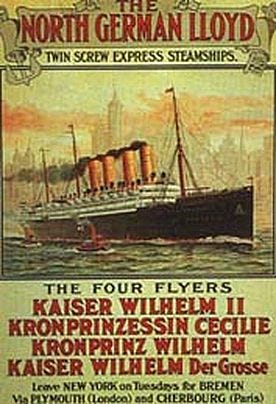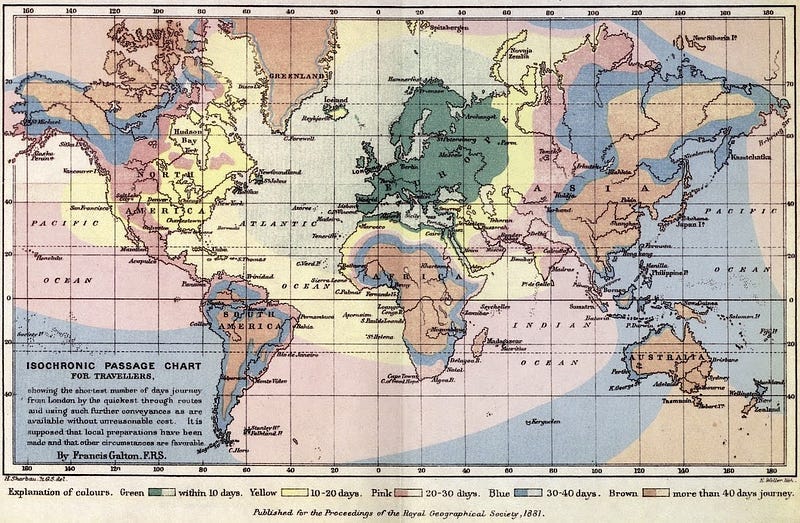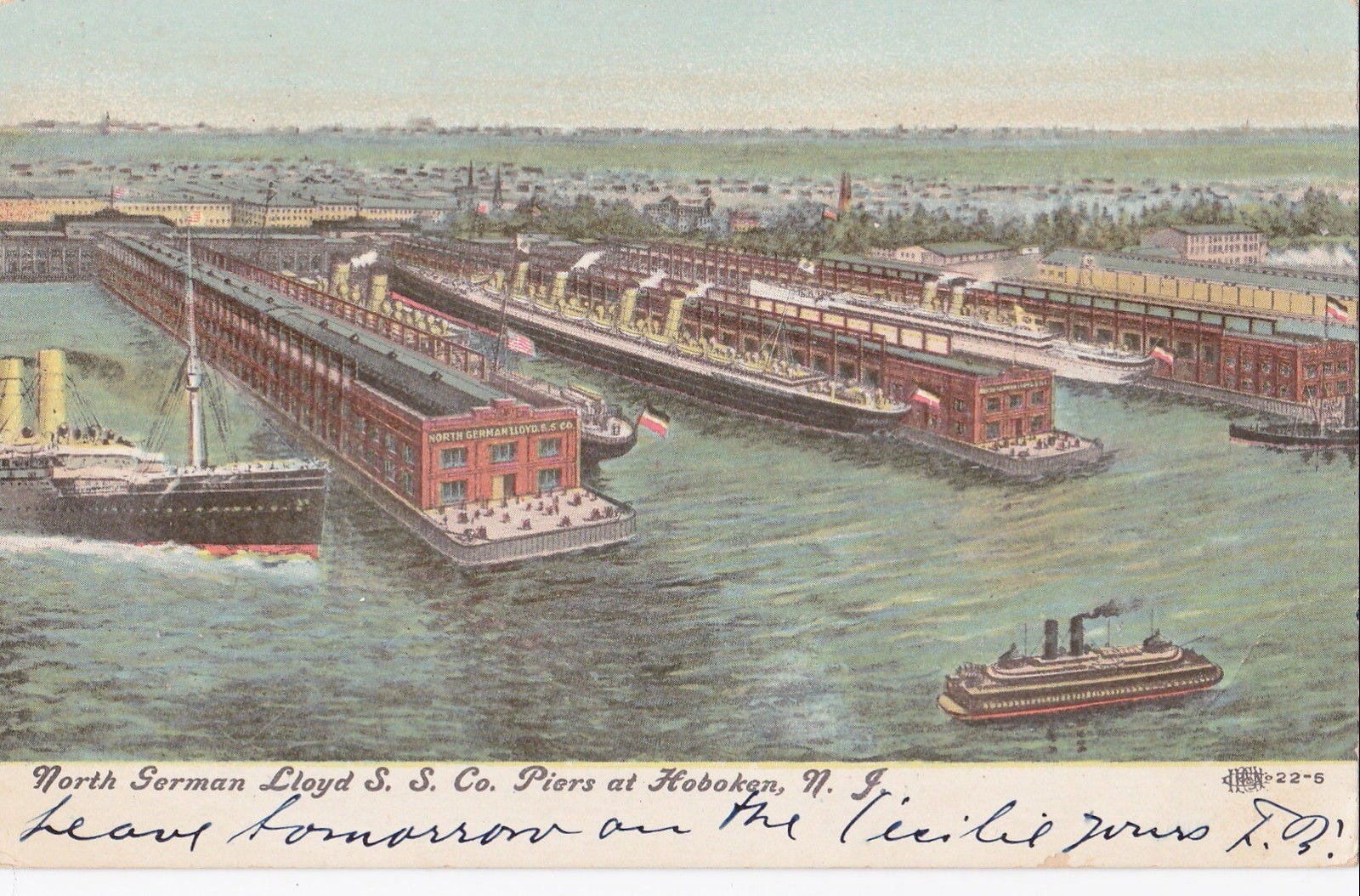There and Back Again. A German’s tale.
Traveling for conferences and talks at the turn of the century.
Traveling to conferences at the turn of the century.
As travel resumes, it's becoming increasingly clear that there's a strong desire to connect, collaborate, and engage with others in person. Prior to the pandemic, I traveled primarily to attend technical conferences, which typically lasted a week, including the event itself. These conferences provided a much-needed boost to my work, passion, and motivation due to the unexpected discoveries and learning opportunities that often arose.
Therefore it is fascinating how people used to go and give talks when traveling wasn’t just sitting on a plane for part of their day but weeks to months of traveling on a combination of coaches, trains, and boats. The time it took sounded insurmountable, not to mention the planning. Then there were the matters that I hadn’t even thought about, those day-long trips needed to take into account all your meals and sleeping arrangements, which I can only suppose were included in some inclusive ticket price. Organizing an international visit to your university must’ve been a pain to organize and fund, much less an international conference.
Around 1905 Ludwig Boltzman wrote a short and hilarious book called “A German Professor’s Journey to Eldorado,” He describes his trip to California from Vienna in 1905 to give a set of lectures at a Summer School at Berkeley. There is little physics discussion; it mainly concerns talking about the lack of and the sneaking around of booze and so many dad jokes.
Physics Today published a redacted version of the translation from german to english 30 years ago, and it can be found here .
Boltzmann was a professor in Vienna studying and developing statistical thermodynamics physics. At the time, the field focused on making sense of hundreds of years of thermal physics experiments and theories (i.e., think entropy, the law of gases, temperature, etc...) with the mechanical dynamics of individual objects that should’ve made up those systems.
An Italian professor once said during a lecture; there are two types of scientists: those who want to watch the football game and those who just want to know the score. Boltzmann was launched into these divisions; molecules and atoms were not measurable objects at that time, and statistical interpretation of the thermodynamics depended on them. Yet we could create perfectly good laws without knowing whether these particles existed. Boltzmann along with Gibbs and Maxwell developed statistical methods that gave entropy its current probabilistic view.
However, his eventual suicide and constant assumptions regarding his mental health are usually sadly highjacked to add a joke to physics books or make some other contrived point about scientists being more relatable or create a story of an underdog. These related and important points will not be discussed here.
On the other hand, California became a state in the United States just 50 years prior in 1850. If you need a historical recap, watch the last two Zorro movies. If that reference is too old for you, I’m talking about the ones involving the voice actor for Puss in Boots, where he played a human puss in boots-like in California in the mid-1800s. Flush with money from tycoons and their families, universities and academic programs invited renowned professors to teach in the summer but also to entice some to move. Ludwig was just such a professor.
The trip starts with a horse carriage heading to the train station
“On June 8th, I attended […] the thursday meeting of the Vienna Academy of Sciences. When I left, a colleague […] asked where I was heading. “To San Francisco”, I answered laconically”
His entire trip took around 18 days, which is in tune with the travel rates of the period. For example, a Travel Times map from London from 1881 shows that the trip to San Francisco takes about 10–20 days. This involves horse-drawn carriages, trains, a stop in Germany for another conference, and a ship from Bremen.
“I moved on to Bremen, and then to New York with a Hohenzollern prince. Not that I had the honor of accompanying this nobleman on a transatlantic voyage; rather, he simply carried me over on his back:”

He took the steamship “Kronprinz Wilhel,” the fastest passenger ship at the time, winning the coveted Blue Ribband accolade in 1902 and 1904. It has a very interesting history of its own, having been commissioned in both the German and American Navy. The ship docked in Hoboken docks of its parent company, across New York City on the Hudson. While he was hoping to jump straight into the train to California, he unfortunately was left stuck for several days in New York City.
“ I immediately hired a cab, which was supposed to take me first to the office of the Southern Pacific Railroad and then directly to the railroad station — all for $3. But at the Southern Pacific office I learned that the express train, for which I had a reduced fare ticket, only goes twice a week. I would have to wait two days in New York.”
That 6-hour delay doesn’t seem so bad now, does it? As you can see from the Travel Times Map, the cross-continental railway makes almost no stops in delivering you to California once you cross the Mississippi. And Boltzmann mentions as so:
“I made it from New York to San Francisco in four days and four nights. You’re simply catapulted”
It does make some stops, particularly in St. Louis and Salt Lake City. His return trip was described quickly and without much fanfare:
“the train carried me away, by way of Portland, Yellowstone, Chicago and New York]…. The return ocean crossing was blessed with magnificent weather. … Now only a brief train ride from Bremen to Vienna, a dashing ride in a Viennese fiaker [horsedrawn cab] and I’m home”
It is clear that the return journey takes him along the northern route of the transcontinental railway system, which is renowned for its breathtaking scenery. However, the current Amtrak site indicates that this route is no longer available for passenger trains. As mentioned, he was invited to participate in the summer school hosted by the University of California, a summer school that dates back to approximately 1900. During this time, significant investments were made in building and enhancing universities in Palo Alto and Berkeley, utilizing both earned and inherited wealth. Despite the assumption that such a trip may be costly, Boltzman was sponsored by benefactors who were investing in both the training of local teachers and attracting talent to the area.
“In Europe alma mater is an idealized figure from antiquity. But in America she’s a real woman with — and this is the crux — real millions. Every year Mrs. Hearst gives several million for the expansion of the university. My trip to America was of course paid for by her with her money. The president of the university … is merely the executive officer of the trustees, over whom Mrs. Hearst presides…”
Besides being enamored with the campus and climate. His account is filled with dad jokes and anecdotes.
“The building is just off Euclid Avenue, and indeed its precise parallelepiped form had no trace of anything non-Euclidean about it. ”
One particular event of note is his visit to Loeb’s lab in Santa Cruz. Loeb revolutionized our understanding of life's intricate mechanisms by demonstrating, around 1899, that he could induce pathogenesis in sea urchins through chemical means. The news quickly traveled around the world. It becomes an important component of our understanding of how animals reproduce, further eroding the idea of vitalism. This together with the re-emergence of Mendel’s findings, created a conjunction that the chemical and physical laws for inanimate objects were the same ones followed by living being. This was similar to what Boltzmann was trying to argue with his work in statistical mechanics. The statistics of a large group of objects following mechanical laws lead to the thermodynamic laws we observe.
However where his mind goes is not only fascinating but also hilarious :
and what social upheavals would follow if this could be done not just with sea urchins but also with .. . human beings! Women would be emancipated to a degree not even dreamt of by the women's rights movement. Men would simply become superfluous, completely replaceable by vials of skillfully mixed chemicals.... Soon they'll find out what mixture yields boys—or girls. And because the former are completely superfluous, they'll just make a few specimens for the zoos. But then, of course, wine will also be superfluous...
I love how he takes the conversation right back to wine instead of some crazed eugenics route. Wine and the lack of it along his trip is a common theme, and several jokes and anecdotes stem from it.
Finally, the experience of Europeans coming to the United States and being perplexed by the cost of healthcare turns out to be nothing new either.
It was extremely interesting to see this American hospital. Its elegance is not inferior to that of the Kaiser Wilhelm II (I mean, of course, the steamship). But the experience cost me $35. It was the most expensive luxury I permitted myself on the entire trip...





